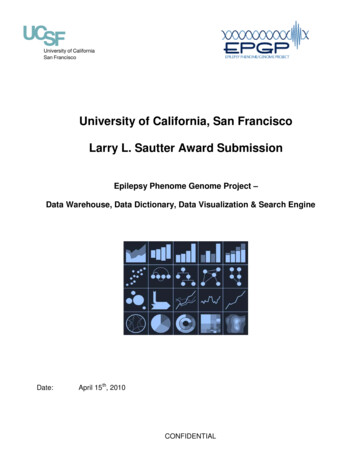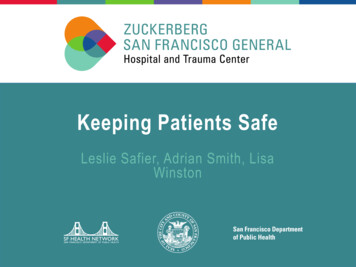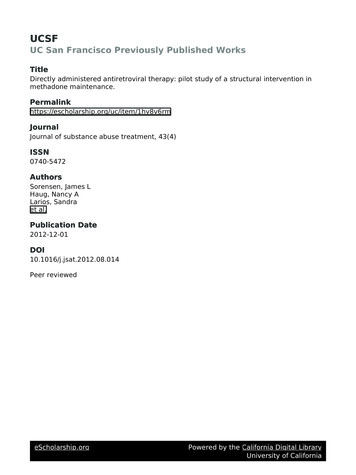
Transcription
University of California, San FranciscoLarry L. Sautter Award SubmissionEpilepsy Phenome Genome Project –Data Warehouse, Data Dictionary, Data Visualization & Search EngineDate:April 15th, 2010CONFIDENTIAL
Table of Contents1.PROJECT TITLE . 22.SUBMITTER’S’ DETAILS . 23.NAMES OF PROJECT LEADERS AND TEAM MEMBERS . 24.PROJECT SIGNIFICANCE . 35.PROJECT DESCRIPTION . 45.1.5.2.5.3.5.4.5.5.5.6.5.7.5.8.5.9.W HAT IS EPGP? . 4EPGP’S CONTRIBUTION EPILEPSY RESEARCH . 4EPGP’S DATA W AREHOUSE . 4EPGP DATA DICTIONARY . 6EPGP DATA VISUALIZATION . 7EPGP ‘S ‘GOOGLE-LIKE’ SEARCH ENGINE . 9CONCLUSION . 12TECHNICAL ARCHITECTURE . 12ABBREVIATIONS USED . 13FEEDBACK FROM STAKEHOLDERS . 14CONFIDENTIALPage 1
1.Project TitleEpilepsy Phenome Genome Project – Data Warehouse, Data Dictionary, Data Visualization andSearch Engine at the University of California, San Francisco2.Submitter’s DetailsGerry Nesbitt, MBA PMPDirector of BioinformaticsUniversity of California, San FranciscoDepartment of NeurologyEpilepsy Phenome Genome ProjectTelephone: (412) 889 3295Email: gnesbitt at epgp.org3.Names of Project Leaders and team MembersBioinformatics Project TeamMr. Gerry Nesbitt, MBA PMPDirector of Bioinformatics, UCSFMr. Kevin MillerData Manager and Senior Developer, UCSFMr. Alan CarpenterSenior Developer, UCSFMs Vickie MaysEEG/MRI Data Coordinator, UCSFMr. Harry LeBlancSenior Data Architect (Contract), UCSFMr. Chris PragashSenior Programmer (Contract), UCSFProject SponsorsDr. Daniel Lowenstein, M.D.Professor of Neurology, Department of Neurology at UCSF, Director of the UCSF Epilepsy CenterRuben Kuzniecky, M.D.Professor of Neurology, Comprehensive Epilepsy Center, NYU Medical CenterCONFIDENTIALPage 2
4.Project SignificanceThe Epilepsy Phenome Genome Project (EPGP) is a multi-center NIH-funded study to create acomprehensive phenomic (clinical) and genetic database in epilepsy. The EPGP project iscollecting large amounts of phenotypic, imaging and genomic data on thousands of studyparticipants. Here we present the projects that were undertaken to design and build a centralizedphenotypic data warehouse and supporting data dictionary, and describe the data visualizationtools implemented for exploring data and presenting results. We have successfully developed,implemented and integrated multiple technologies, and have accelerated the flow of criticalinformation to key stakeholders as a result.The EPGP data warehouse was designed based on a simple conceptualization consisting ofinterconnected architectural layers, and currently contains over 1.5 million data points. It ispopulated every 6 hours from disparate transactional databases that contain clinical,electrophysiological, and neuroimaging data using custom-developed ETL tools. The EPGP datadictionary contains definitions of more than 2670 clinical data elements and is used by variousend-user applications to explore, visualize and analyze the huge amounts of data in EPGP’s datawarehouse.We anticipate that the combined EPGP data warehouse will help researchers to identify thegenetic contributions that cause specific epilepsy syndromes and predict the therapeutic efficacyof anti-epileptic drugs (AEDs). And finally, the EPGP data warehouse will establish a resourcethat will be available to other researchers who will apply new analytical methods in the future thatare impractical or unimagined today.CONFIDENTIALPage 3
5.Project Description5.1.What is EPGP?The Epilepsy Phenome Genome Project (EPGP) is a multi-center NIH-funded study to create acomprehensive phenomic (clinical) and genetic database in epilepsy. EPGP will conductgroundbreaking research that will characterize the clinical, electrophysiological, and neuroimagingphenotypes of 3,750 patients with discrete subtypes of idiopathic-generalized, focal, or severeearly-onset pharmacoresistant epilepsy.5.2.EPGP’s Contribution Epilepsy ResearchThe EPGP project will provide an excellent patient population to address the significance ofgenetic contributions to certain types of epilepsy. The rigorous collection of phenotypic data, drugresponse data and a large sample of patients will provide significant power to detect clinicallymeaningful associations between genetic polymorphisms and the epilepsy phenotype.Furthermore, the proposed whole-genome analysis will allow us to consider novel drug responsegenes and is likely to significantly enhance our understanding of the biology of anti-epileptic drugresponse.In addition, the EPGP will establish a national resource that will be available to other researcherswho will apply new analytical methods in the future that are impractical or unimagined today. TheEpilepsy Phenome/Genome Project engenders the prospect of major advances in epilepsyresearch that will ultimately be of direct benefit to patients.5.3.EPGP’s Data WarehouseDefinition:Data Warehouse -- A data warehouse is a repository of an organization's electronically storeddata.The EPGP project is collecting a large amount of phenotypic, imaging and genomic data onthousands of study participants. To discover new knowledge from these data, they need to becentralized in a data warehouse and made accessible to various end-user data reporting,exploration and visualization applications.Because it was difficult to develop reports or do data analysis against EPGP’s transactionaldatabases due to their complexity, the EPGP data warehouse was designed to facilitate easierreporting and analysis. It was necessary to integrate heterogeneous data sources into acomposite data repository that would facilitate easy data exploration and data visualization.Custom tools were developed to build and maintain the data warehouse, and off-the-shelf toolswere procured to provide data exploration and data visualization capabilities.CONFIDENTIALPage 4
EPGP’s transactional databases were highly normalized to ensure the data was free of dataanomalies, thereby providing better data integrity. This made the underlying data architecture ofthe transactional databases very complex and would not be feasible for end-users to considerrunning data reporting or data visualization applications against them. Therefore, we needed tobuild a read-only data warehouse that was denormalized to simplify the data architecture, andwould empower end-users to conduct their own business intelligence activities.EPGP’s transactional databases contain all the phenotypic data collected on all study participants,and was gathered using web-based data collection instruments. These data are used to populatethe data warehouse. We knew we had to decouple these transactional databases data from thedata warehouse and decouple the data warehouse from the end-user business intelligenceapplications, so the architecture of the data warehouse was designed on a simpleconceptualization consisting of the following interconnected layers:Operational Database LayerThis layer is the source data for the data warehouse, and includes data stored in varioustransactional databases and file systems.Data Access LayerThis layer is the interface between the operational and informational access layers. Itconsists of custom developed ETL tools to extract the data from the source databases andload it into the EPGP data warehouse.Informational Access LayerThis layer consists of the data stored in the data warehouse and is accessed by the toolsand applications that facilitate data reporting, data visualization, data mining, and analysis.Metadata LayerThis layer is comprised of the EPGP data dictionary that describes all the data elements inthe EPGP data warehouse, and is used by the end-user business intelligence applications,like the data reporting and data visualization applications.CONFIDENTIALPage 5
Figure 1 - High-level Data Warehouse ArchitectureEPGP has designed and implemented a data warehouse that contains all of EPGP’s phenotypicdata. We have automated the ETL process to import clinical data from disparate transactionaldatabases ever 6 hours so that the data stays relatively current. Over 20 reports, developedusing MS SQL Server Reporting Server 2008 , are now using the data warehouse and executea lot faster than if programmed against the transactional databases.5.4.EPGP Data DictionaryThe EPGP data dictionary is a catalogue of all EPGP’s clinical data elements. It consists ofmetadata that describes the underlying data in the data warehouse, and is a critical componentdue to the volume and diversity of data in the data warehouse, the many end-users who willaccess the data and the multiple data sources used to populate it. The data dictionary containsinformation about EPGP’s data items, such as data point name, data type, length, description,origin, usage, format and encoding.The EPGP data dictionary contains definitions of more than 2670 clinical data elements. We useda MS Excel spreadsheet to store the metadata on each clinical data element. The reason for thisCONFIDENTIALPage 6
was because it was much simpler approach than say implementing the somewhat complexISO/IEC 11179 Metadata Registry (data dictionary) standard, and the clinical data elements werestill in a state of flux so the data dictionary needed to be extremely adaptable to constant andrapid change.Figure 2 - Data DictionaryTo date, EPGP has collected 1,551,408 phenotypic data points on over 1700 study participants,encompassing clinical, electrophysiological, and neuroimaging data.5.5.EPGP Data VisualizationThe EPGP study is gathering a vast amount of research data, which could provide novel insightsinto epilepsy syndromes when explored. Data visualization provides an excellent approach forexploring data and presenting results using meaningful charts, and therefore plays a crucial role intrying to understanding data. The goal of data visualization is to communicate information clearlyand effectively through graphical means, and facilitate data reporting, data mining and dataanalysis. It enables data stored in EPGP’s large phenotypic datasets to be condensed intomeaningful visual representations and facilitates visual comparisons of data. Researchers wishingto explore or visualize the data are not restricted to a specific package, i.e. they can usecommonly available applications like MS Excel , MS Access and SAS to explore the data,and other 3rd party software tools to visualize the data, such as Omniscope .CONFIDENTIALPage 7
Figure 3 - Viewing Data in the Data WarehouseEnd-users can use a MS Excel spreadsheet to view the data in the data warehouse, using each ‘tab’ topoint to a specific database table.There are seven stages to visualizing data, which are1. Acquire2. Parse3. Filter4. Mine5. Represent6. Refine7. Interact.EPGP procured a data visualization and charting tool, called Omniscope , because it allowedthe end-user to control each of these steps in the data visualization process, and perform datavisualization in a progressive and iterative manner. This tool also suited the intuitive design ofEPGP’s data warehouse, and was easy to implement and use from an end-users perspective.Figure 4 - Data Presented by Geographical LocationCONFIDENTIALPage 8
Figure 5 - Various Data Visualization ChartsA number of measures are in place to control access to the applications and the data, ensuringcompliance with standards like HIPAA and 21CFR11. No patient-identifying information is storedin the databases. All end-users are assigned a unique username and password, and access tothe applications depends on the permissions assigned to them. The databases have role-basedsecurity implemented and all web-based applications are run over HTTPS using SSL 128-bitencryption, ensuring that all communications between the browser and web application areencrypted.End-users can exploit a variety of business intelligence tools to explore and view the data in thedata warehouse. EPGP implemented the Omniscope tool to empower the end-users with datavisualization capabilities. It is used by study management personnel and researchers to report onand analyze the data, and requires minimal effort to implement the software and train end-users.These tools have enabled study management personnel and researchers to explore the everexpanding volume of phenotypic data that are stored in easy to interpret formats.5.6.EPGP ‘s ‘google-like’ Search EngineIn an effort to make EPGP’s phenotypic data available to as wide an audience as possible, weimplemented a ‘google-like’ search engine called Tabula DX, which enables searching acrosslarge collections of PDFs. We developed a program that creates PDFs for all the phenotypic data(surveys, EEG data and MRI data) in the data warehouse. This program is run automatically eachnight to create PDFs for the data collected since the last run. Once these PDFs are created, thesearch engine indexes the contents of each new PDF and makes the document available via thesearch website.CONFIDENTIALPage 9
To run a search, the end-user enters the search string in the field and clicks [Search]. The searchresults returned include a thumbnail of the PDF document, the document title, a section of the testin the PDF that contains the search string, and a link to open the PDF file with ‘Find’.Figure 6 – EPGP’s Search Engine WebsiteThe search website also includes options for filtering the data. Examples of some search stringsinclude:Search StringExplanationEPGP011100Retrieves survey responses, EEG data and MRI data for the subject EPGP011100.EPGP011100 AEDRetrieves the AED Data Sheet for EPGP011100.EPGP011100 DemographicsRetrieves the Subject Demographics & Ethnicity survey response for EPGP011100.BaseballRetrieves all survey responses that contain the word “Baseball”Baseball LaserRetrieves all survey responses that contain the words “Baseball” AND “Laser”Baseball OR LaserRetrieves all survey responses that contain the word “Baseball” OR “Laser”Baseball NOT LaserRetrieves all survey responses that contain the word “Baseball” but not “Laser”"Baseball bat"Retrieves all survey responses that contain the text string “Baseball bat”keywords:IGERetrieves all survey responses that contain the keyword “IGE”title:FinalRetrieves all survey responses that contain the word “Final” in the titleCONFIDENTIALPage 10
Figure 7 – Search FiltersFigure 8 – Open Document with FindCONFIDENTIALPage 11
5.7.ConclusionEPGP’s data warehouse and suite of data visualization tools have been extremely successful, notbecause of its architecture or its structure, but rather on its ability to generate ideas that help tobuild, maintain and enhance the use the data warehouse. The EPGP data warehouse is nowaccessible to all EPGP researchers using a broad range of reporting and data visualization tools,and the number of end-users continues to grow. The ETL informatics tools were customdeveloped for EPGP but the architecture provides a feasible model for widespread use on otherclinical studies throughout UCSF.We anticipate that the combined EPGP data warehouse will help researchers to identify thegenetic contributions that cause specific epilepsy syndromes and predict the therapeutic efficacyof AEDs. And finally, the EPGP data warehouse will establish a resource that will be available toother researchers who will apply new analytical methods in the future that are impractical orunimagined today.5.8.Technical ArchitectureO/S: Windows Server 2003 R2Database: MS SQL Server 2008Reporting: MS SQL Server Reporting Server 2008Development: MS Visual Studio, Visual C#, SQL Stored ProceduresData Visualization: Visokio - OmniscopeSearch Engine: AquaForest - Tabula DXCONFIDENTIALPage 12
5.9.Abbreviations UsedEPGP:Epilepsy Phenome Genome ProjectETL:Extract, Transform and LoadAED:Anti-epileptic DrugHIPAA:Health Insurance Portability and Accountability Act (HIPAA) of 1996ISO/IEC 11179: ISO/International Electrotechnical Commission (IEC) 11179 MetadataRegistry (data dictionary) StandardCONFIDENTIALPage 13
Feedback from StakeholdersDr. Daniel Lowenstein, M.D.Professor of Neurology, Department of Neurology at UCSF, Director of the UCSF Epilepsy Center“The EPGP data warehouse is a superb resource that will be mined and explored byresearchers trying to discover the genetic contributions that cause specific epilepsysyndromes and to identify better epilepsy drug therapies. The EPGP bioinformatics team atUCSF has done a phenomenal job implementing the data warehouse, data dictionary, datavisualization tools and search engine for such a large-scale research study in less than sixmonths. There is no question that the work of the bioinformatics team has been a criticalfactor in the success of the project to date.”CONFIDENTIALPage 14
Search Engine at the University of California, San Francisco 2. Submitter's Details Gerry Nesbitt, MBA PMP Director of Bioinformatics . University of California, San Francisco . Department of Neurology . Epilepsy Phenome Genome Project . Telephone: (412) 889 3295 . Email: gnesbitt . at epgp.org . 3. Names of Project Leaders and team Members .










